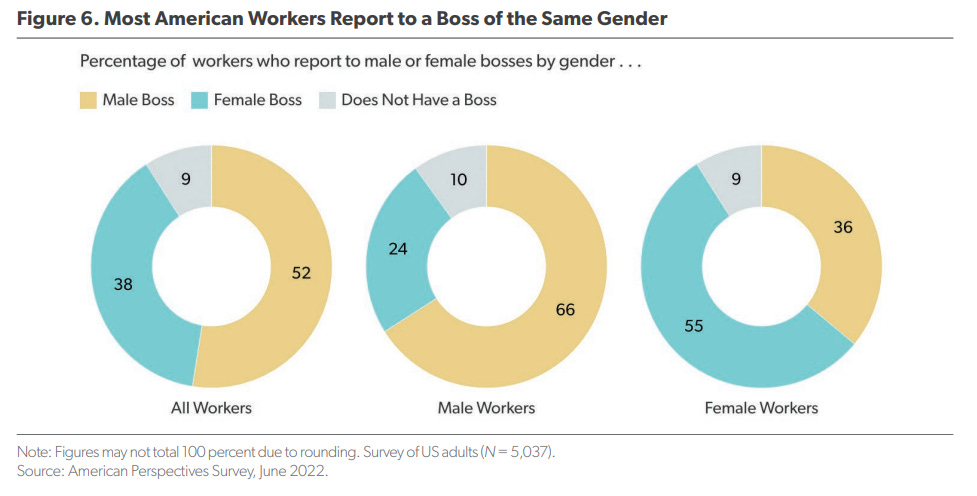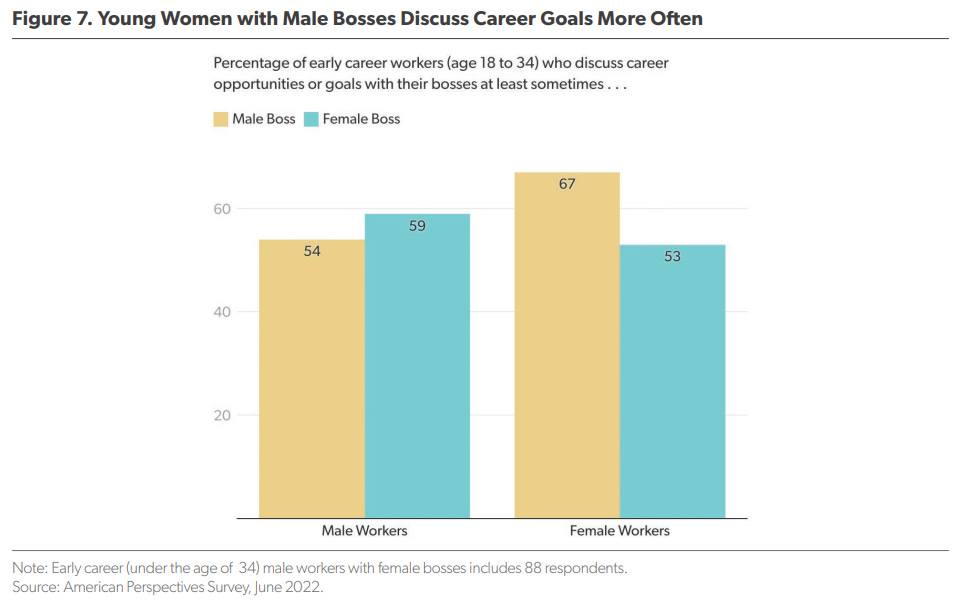Gender and bosses in the workplace
The report The Social Workplace: A Compendium (6/11/2024) is “a compendium of survey data and analysis developed as part of a multiyear project looking at the social dimension of work and the economic, psychological, and emotional experience of American workers.” There are more than a dozen figures , and two caught my attention. The first graph notes that while the majority of workers report to a male boss (52%), the majority of workers report to a boss of the same gender. Why? I’m going to guess that one of the explanations is that men and women are generally attracted to different careers. For example, about 80% of elementary and middle school teachers are female, while about 80% of computer programmers are male.
In the end, this is not entirely surprising. Now, one would then expect that about 55% of the time, a female would speak to a female boss about career goals and about 36% of the time, a male boss, while 66% of men would do the same with a male boss and 24% of the time with a female boss. In other words, it would mirror the percentage of bosses by gender. Well, the second graph I’m copying from the report is not what we
would expect. When a female worker talks to a boss about career goals, 67% of the time that person is male, which is almost double the percentage of females that have male bosses. Similarly, 59% of the time, a male worker speaks to a female boss about career goals, yet only 24% of them have female bosses. I’ll note that the report doesn’t represent this correctly when they say
Early career men with a female boss (59 percent) are not significantly more likely to discuss career opportunities than are those with a male boss (54 percent).
because the results should be normalized by the ratio of male and female bosses. Why does this matter?
As one example, in higher education, we are told that students need to have faculty that are like them for mentorship. Yet, this study suggests that the opposite is true, at least for males and females, if not by race and ethnicity.
Nope, we don’t learn from failure
From The exaggerated benefits of failure (2024) in the Journal of Experimental Psychology: General.
Our culture teaches that failure has, at least, one silver lining: It is a steppingstone to success. Is it? Across 11 studies, people in the lab and professionals in the field overestimated the rate at which health failures, professional failures, educational failures, and failures in a real-time task were followed by success. People thought that tens of thousands of professionals who fail standardized tests would go on to pass (who do not), that tens of thousands of people with addiction would get sober (who do not), and that tens of thousands of heart failure patients would improve their health (in fact, they do not). Overestimating success following failure had key policy implications. Apprising citizens of the true, lower-than-expected rate at which success occurs on the heels of failure increased support for policy initiatives aimed at helping criminals and people in the throes of drug addiction learn and grow from past mistakes. (PsycInfo Database Record (c) 2024 APA, all rights reserved)
Failure isn’t so great. Avoid it.
From the garden
Two different roses, a happy bee on milkweed (we let a cluster grow in the yard), and a hydrangea.




The left-right divide
No one argues about the existence of gravity because it is a fact. What we argue about typically comes down to value judgements. For example, there is no fact that says when or if abortion should be legal. Ultimately, this is a value judgment about an unborn fetus versus the mother. There is no absolute right answer, even though both sides will tell you they are right. Issues like this need compromise to get resolved, or we will just keep fighting about them. Two recent polls demonstrate more of this value divide, and at the moment, compromise might be hard to come by.
The first is from the article Creating More Inclusive Public Spaces Two Years Later. (6/18/2024) Only 36% of Democrats think Confederate monuments and memorials should not be removed, compared to 87% of Republicans. There is no right or wrong here, and the title of the article makes it clear what side the authors are on. When someone uses a phrase like “inclusive spaces,” a fair question to ask is: inclusive to whom? In the end, we are a democracy, but despite which party is in charge at any time, an issue like this needs discussion and compromise; otherwise, one side is going to feel like their views have been squashed.
The second graph comes from the Gallup article Increase in Liberal Views Brings Ideological Parity on Social Issues. (6/10/204)
The shift in social views among Democrats is large, with a 30 percentage point increase in liberal social views. Meanwhile, Republicans increased only 10 percentage points on having conservative social views. This means that both groups exist in more of an echo chamber, but keep in mind that Democrats have shifted their views drastically and have more of a megaphone with overrepresentation in the media and education. Take a moment and think about how you might feel if you were socially conservative in the country at this time. You would feel somewhat under attack. As I noted in my post on Tuesday The left-right understanding gap, “If you want to position yourself as the intelligent, informed group, you should make more of an effort to understand the other viewpoint.” I’m sure many Democrats reading this would say their social liberalism is a matter of compassion, but then I’ll ask, compassionate to whom? But maybe more importantly, who is it not compassionate towards? You are not required to change your opinion as a result, but I do think we should all be aware of those who our opinions negatively affect as well as those who they positively affect.
Climate adaptation
Some people are accepting reality and proposing plans to adapt to climate change. This image is from the paper A Science and Community-Driven Approach to Illustrating Urban Adaptation to Coastal Flooding to Inform Management Plans (3/29/2024), which provides ways to design the urban environment to deal with rising sea level. None of this has to be done all at once, but this does provide a blueprint for what should be done over time.
Graph of the week
This one comes from Damage to tropical forests caused by cyclones is driven by wind speed but mediated by topographical exposure and tree characteristics (5/15/2024). Note: EXP is topographical exposure to wind and MSW is maximum sustained wind speed. Notice that the proportion of damage to trees is not linear with increase of wind speed. For example, at a MSW of 50, the proportion of damage is about 12.5, but at a wind speed of 70, the proportion of damage is about 37.5. The wind speed increased by 40%, but the proportion of damage went up by 300%. Keep this in mind if you are in a hurricane.
Data center update
Microsoft is planning to invest €6.69 billion ($7.16bn) in developing new data centers in the northeastern region of Aragon, Spain.
The investment is expected to span the next 10 years.
According to El Heraldo's report, the data center campus will span 80 hectares.
Note that 80 hectares is about 200 acres.
Tract has acquired another 8,590 acres of land in Reno, Nevada. The company has now assembled more than 11,000 acres across three separate projects around Reno for data center development.
The spinning CD
Ok, not a song this week but another one from Rick Beato. If you are curious about the music AI can create, listen to this one. He also makes the interesting point that over the years, we have used computer tools to adjust music, which has made it harder to distinguish between human and AI music.
Please share and like
Please help me find readers by forwarding this article to your friends (and even those who aren't your friends), sharing this post on social media, and clicking like. If you have any article ideas, feedback, or other views, please email me at briefedbydata@substack.com.
Thank you
In a crowded media market, it's hard to get people to read your work. I have a long way to go and I want to say thank you to everyone who has helped me find and attract subscribers.
Disagreeing and using comments
I'd rather know the truth and understand the world than always be right. I'm not writing to upset or antagonize anyone on purpose, though I guess that could happen. I welcome dissent and disagreement in the comments. We all should be forced to articulate our viewpoints and change our minds when we need to, but we should also know that we can respectfully disagree and move on. So, if you think something said is wrong or misrepresented, then please share your viewpoint in the comments.










